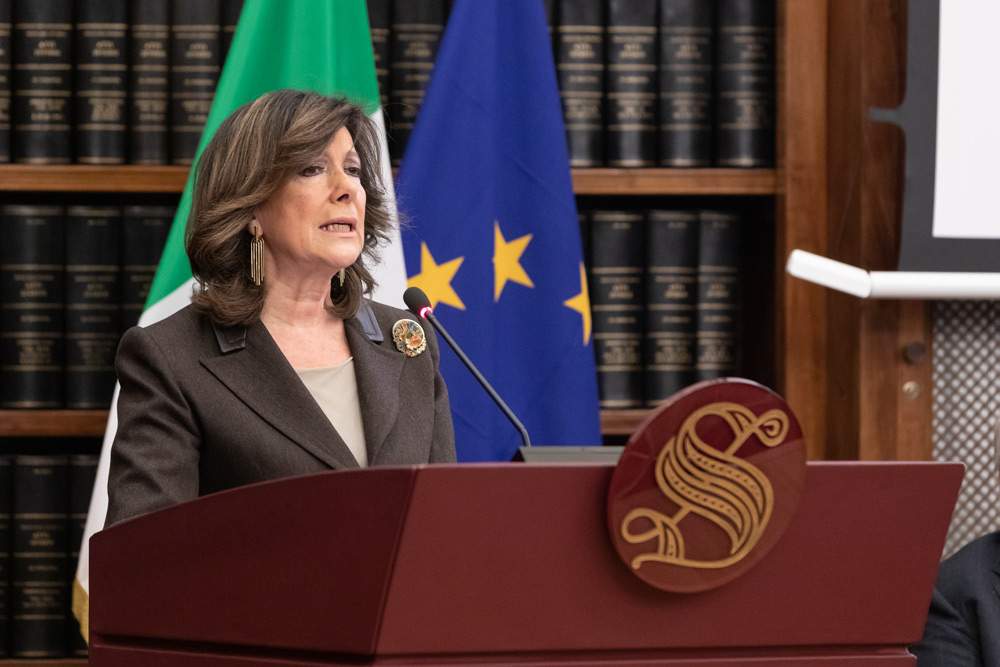Caravaggio debate enters the Senate: Maria Elisabetta Alberti Casellati speaks on the Vocation of St. Matthew
Caravaggio enters, indeed re-entersafter four centuries, the Palazzo Madama. And with him the debate, recently fueled by new contributions, on the Vocation of St. Matthew and in particular on who in the painting is the “real Matthew.” The occasion, was the presentation of the Cardinal Francesco Maria Del Monte Foundation which took place precisely at the Senate headquarters on February 4.
The newly formed Foundation, has among its aims and purposes the "promotion of the figure and works of Cardinal Francesco Maria Del Monte through research and dissemination activities concerning the various fields more generally on issues concerning the late Renaissance" (see the institutional website www.fondazionecardinalefrancescomariadelmonte.it). It is worth mentioning in this regard how the cardinal made his home in Palazzo Madama the crossroads and driving force behind the cultural and scientific activities of the time.
 |
| Caravaggio, Vocation of St. Matthew (1599-1600; oil on canvas, 322 x 340 cm; Rome, San Luigi dei Francesi, Contarelli Chapel) |
 |
| Ottavio Leoni, Portrait of Cardinal Francesco Maria del Monte (1616; black pastel and traces of white on paper, 229 x 165 mm; Sarasota, Ringling Museum of Art) |
And important was his friendship with Galileo Galilei and Caravaggio, and the protection given to both. Of the scientist, to whom moreover he suggested the use of mountain crystal in place of glass in the construction of lenses, the prelate assumed the defense when the latter was denounced to the Holy Office.
Caravaggio, on the other hand, who thanks to Del Monte often obtained his release when he had trouble with the law, resided at Palazzo Madama for a number of years as early as 1597. Documents tell us that it was here that he painted such pictures as the Nativity of Palermo and the side paintings in the Contarelli Chapel with the stories of St. Matthew: the Vocation and the Martyrdom of the saint.
And it is precisely the Vocation of St. Matthew that is at the center of a critical debate, reopened in recent months by the volume Caravaggio. The True Matthew by Sara Magister (Campisano Editore, with a preface by Antonio Paolucci and a contribution by Michele Cuppone). One wonders, in essence, who among the characters depicted is St. Matthew, whether specifically the bearded man who seems to point to himself as generally believed, or the young man bent over counting coins as has been increasingly suspected of late.
 |
| Cover of the book Caravaggio. The Real Matthew by Sara Magister |
Unexpectedly, a new voice has now entered the discussion and it is that of Senate President Maria Elisabetta Alberti Casellati, who presided over the Feb. 4 meeting. The second highest state office not only introduced the new hypothesis as an "accredited reinterpretation." More, she emphasized the artist’s “use of theology to accompany painting, of beauty to illuminate theology,” a use to which evidently this painting, and its rereading, now lead us to reflect more consciously.
Below is the relevant passage of his speech (in the video, a larger fragment):
"It was precisely at Palazzo Madama that the Cardinal patron hosted the young talent, and in what is now the seat of the Senate that a number of key works were produced.
First of all, “The Musicians,” a work by Caravaggio that represents more than an interpretive trace of the Cardinal’s thought. Caravaggio - allow me this hyperbole - “draws music,” represents it, stages it, embodies it. This is no accident, no coincidence: it is Del Monte’s deepest intuition to draw music, to musicalize art, to poetize prose.
A very recent and, though still a minority, accredited reinterpretation of the “Vocation of St. Matthew” - a work that Caravaggio also painted at Palazzo Madama - invites us to rediscover the “real Matthew,” which we can admire in the Contarelli Chapel of the nearby Church of San Luigi dei Francesi, no longer in the bearded figure with his index finger raised, but in the young man bent over counting denarii at the bottom of the table.
Itis not so much the in some respects unbelievable reinterpretation of one of Caravaggio’s best-known and most appreciated works that should surprise us, but rather the artist’s use of theology to accompany painting, of beauty to illuminate theology. For Caravaggio after all, Del Monte represented not only the patron, the mentor, the defender during the most difficult phases of the so-called black legend, but the Master, the guide who opened the gateway of the ideal to the real, of the transcendent to the immanent, of aesthetics to practical life" (Maria Elisabetta Alberti Casellati, Rome, 4/2/2019).
Pictured below: Maria Elisabetta Alberti Casellati
 |
| Caravaggio debate enters the Senate: Maria Elisabetta Alberti Casellati speaks on the Vocation of St. Matthew |
Warning: the translation into English of the original Italian article was created using automatic tools. We undertake to review all articles, but we do not guarantee the total absence of inaccuracies in the translation due to the program. You can find the original by clicking on the ITA button. If you find any mistake,please contact us.




























